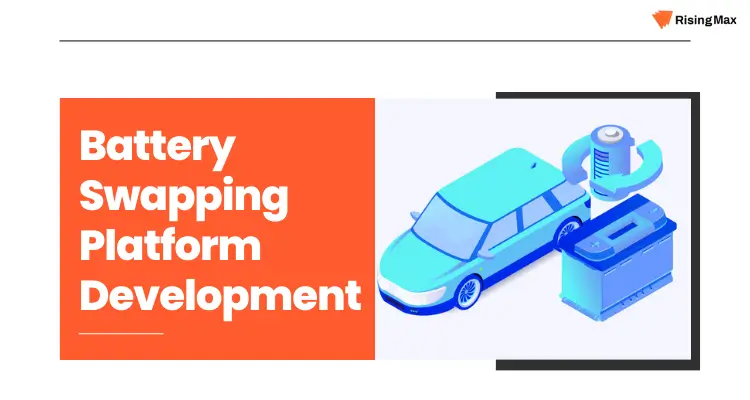Join us in shaping the future of clean transportation.
The world increasingly focuses on sustainability, and battery swapping stations offer a game-changing solution. Whether you’re an electric vehicle owner, a fleet manager, or an infrastructure provider, this platform streamlines the process of replacing batteries, extending the life of EVs, reducing downtime, and minimizing environmental impact.

The battery swapping platform development is the result of relentless innovation and a deep commitment to environmental responsibility. It addresses the challenges of electric vehicle adoption by providing a seamless and efficient way to exchange depleted batteries for fully charged ones.
With our expertise in EV charging software development, we’re driving into the latest venture of battery swapping technology, creating a more accessible and sustainable world for all. Our platform redefines the way we power electric vehicles, making them not only efficient but also eco-friendly.
Battery Swapping Stations: Next-Gen Automotive Industry’s Solutions
Battery swapping stations, particularly for electric vehicles (EVs), are an emerging and innovative solution. Battery swapping platforms are designed to facilitate the exchange of depleted EV batteries with fully charged ones, offering a convenient and time-efficient solution for electric vehicle users.
These platforms typically involve user-friendly apps or kiosks at designated swapping stations, where customers can quickly replace their EV batteries instead of waiting for traditional charging. Battery swapping is seen as a solution to address challenges such as long charging times, limited charging infrastructure, and concerns about battery degradation.
The market size for battery swapping platforms was evolving rapidly due to the growing adoption of electric vehicles and the need for innovative charging solutions.
Embark On Electrifying Journey Toward Cleaner, More Sustainable Transportation!
RisingMax’s battery swapping platform is at the forefront of the electric vehicle revolution, and we’re excited to have you on board. Together, we’re driving change, one battery swap at a time.
Various Battery Swapping Techniques And Associated Features of Our Platform
The choice of battery swapping technique depends on factors such as the type of vehicle or device, infrastructure, automation level, and user convenience. Each technique has advantages that should be considered when implementing a battery swapping system.
Manual Battery Swapping
This is the simplest technique for small vehicles, where trained personnel physically remove the depleted battery and replace it with a fully charged one.
Automated Battery Swapping
It uses robotics to replace the battery without human intervention. The vehicle is positioned over a swapping bay, and equipment replaces the battery.
Slide-Out Battery Packs
Some EVs are designed with slide-out battery packs. When a swap is needed, the user can easily slide out the depleted battery and insert a fully charged one.
Battery Pack Modules
Batteries are divided into modules that are individually replaced. When a module degrades, only that module is swapped out, which helps in reducing costs.
Battery Skates
In this technique, the entire battery is mounted on a skate-like platform. When a battery swap is needed, the battery skate is replaced with a charged one.
Battery Cooling Management
Some systems use cooling and thermal management techniques to ensure the swapped battery’s temperature is optimal for performance and longevity.
Also Read: On Demand Delivery Market Size
Why Businesses Need To Start Battery Swapping Stations
A battery swapping platform or station provides businesses with a practical and sustainable solution for managing their electric vehicle fleets, reducing costs, and improving operational efficiency, all while aligning with environmental and customer-centric goals.
Reduced Downtime
Battery swaps are quicker than traditional charging, minimizing downtime for electric vehicle (EV) fleets. This results in increased efficiency and productivity.
Extended Vehicle Life
Regular battery swaps extend the life of electric vehicle batteries, reducing the need for costly replacements and increasing the overall return on investment.
Competitive Advantage
Adopting a battery swapping platform gives a competitive edge by offering eco-friendly services compared to others relying on traditional charging methods.
Enhanced Customer Experience
Offering quicker and more convenient electric vehicle services attracts and retains customers, whether for ridesharing, delivery services, or other applications.
Cost Efficiency
Lower maintenance and reduced downtime lead to cost savings for businesses operating electric vehicle fleets. This transforms into improved profitability.
Sustainability
Battery swapping promotes sustainable EV use by reusing batteries. It aligns with social sustainability goals, appealing to environmentally conscious customers.
Reliability
Battery management systems ensure that swapped batteries are well-maintained and reliable, minimizing the risk of power-related failures during operations.
Operational Flexibility
Users can swap batteries at convenient times, helping electric vehicle businesses manage fleets efficiently without being constrained by rigid charging schedules.
Adaptability
As battery technology evolves, businesses easily integrate new battery types into fleet through the platform, keeping up with the advancements in EV technology.
Get A Free Consultation For Custom Battery Swapping Solutions!
Reach out for a free consultation to discuss your specific requirements. Our dedicated team tailors an advanced battery swapping solution to their needs.
Enticing Features Of Our Battery Swapping Platform
A battery swapping platform typically offers various key features. These features enhance the overall user experience and ensure the efficient operation of the battery swapping platform service.
Fast & Convenient Swaps
We design a user-friendly interface that allows EV owners to swap their batteries, reducing the time spent waiting for recharging. They can do everything just by logging into the custom-developed app or web.
Enhanced Sustainability
By promoting easy battery swapping and replacement, our platform significantly reduces the carbon footprint associated with EV battery production.
Economical Solution
Our platform is not just environmentally responsible; it’s also cost-effective. Fleet operators optimize their operations by reducing costs.
Smart Battery Management
The platform employs intelligent algorithms to track battery health, ensuring users always receive reliable, well-maintained batteries.
User-Friendly Interface
With an intuitive app interface, customers effortlessly schedule, track, and complete battery swaps, making the process hassle-free.
Environmental Impact
By promoting battery reuse, our platform significantly reduces the ecological footprint of EVs, contributing to a cleaner planet.
Scalability
Whether you’re an individual EV owner or a large fleet operator, our platform is adaptable to meet your specific business needs.
Secure Transactions
We prioritize the security of your battery swap transactions, utilizing cutting-edge authentication protocols to safeguard your data.
Maintenance Alerts
Let your consumer receive timely notifications about battery maintenance needs, ensuring the longevity and performance of your EV’s power source.
Comprehensive Support
Our dedicated customer support team is available around the clock, ensuring a smooth experience with our battery swapping platform.
Also Read: How AI Can Help CEOs
Revenue Stream For Battery Swapping Stations
Battery swapping stations can generate revenue through various streams. The success of revenue streams depends on factors such as location, demand, pricing strategy, and the overall business model of the battery swapping station.
Battery Swap Fees
Charging customers a fee for swapping their depleted batteries. Pricing models can be per-swap, subscription-based, or pay-per-use.
Subscription Services
Offer subscription plans to regular users, providing them with discounted or unlimited swaps for a monthly or yearly fee.
Battery Charging Services
Provide traditional charging options (e.g., fast charging) alongside swapping and charging customers for energy consumed.
Fleet Services
Partner with electric vehicle (EV) fleets to offer battery swapping services, charging a fee per swap for their entire fleet.
Maintenance & Repairs
Offer maintenance services, such as battery diagnostics, repair, and recycling, generating revenue from recycling fees.
Advertising
Collaborate with EV manufacturers and brands for advertising and promotional partnerships within the swapping stations.
Data Services
Collect data on battery usage and charging patterns, then sell insights to OEMs, energy companies, or government agencies.
Government Incentives
Explore government subsidies, grants, or incentives for promoting sustainable energy solutions, which can supplement revenue.
Franchise Model
Allows entrepreneurs to operate franchise swapping stations, earning a portion of their revenue through licensing fees.
Ready To Launch Your EV Battery Swapping Station?
Request a demo of your battery swapping platform and see the system in action. We adapt and create bespoke systems to meet your unique requirements.
Battery Swapping Platform Development Process
Throughout the development process, we maintain clear communication with stakeholders to ensure alignment with project objectives and to accommodate any changes or additions as needed. Our aim is to create a battery swapping platform that’s efficient, reliable, and user-friendly, meeting the evolving needs of our users.
Conceptualization
Our dedicated development team starts the process by identifying the core objectives and requirements of the platform. This involves market research, stakeholder interviews, and setting project goals.
Planning
We create a comprehensive project plan, defining timelines, milestones, and resource allocation. This stage involves architectural design, technology stack selection, and a detailed development roadmap.
Development
Our development team follows an agile approach, building the platform’s components in iterative sprints. This includes creating the user interface, backend systems, and integration with hardware devices.
Testing
Rigorous testing is conducted by our quality assurance and testing team to ensure the platform’s stability, security, and functionality. This includes unit testing, integration testing, and user acceptance testing.
Deployment
Once testing is successful, we deploy the platform on a scalable and secure infrastructure, ready for public use. We provide user training and support to ensure a smooth transition to a battery swapping system.
Also Read: Top 10 IT Business To Start In Dubai
Choosing RisingMax Inc. For Battery Swapping Platform Development
RisingMax Inc., a top-rated battery swapping platform development service provider, assists EV businesses and startups in joining the digital transformation journey. Here’s why our clients trust us for battery swapping station development.
- Experienced Team
- Innovative Solutions
- Tailored Solutions
- No Hidden Cost
- Flexible Engagement
- Lasting Support
Contact our experts to have a market-ready battery swapping platform solution.
FAQs Related To Battery Swapping Platforms
Some frequently asked questions related to battery swapping.
How does the battery swapping platform work?
Battery swapping involves exchanging a depleted battery for a fully charged one at a swapping station. The old battery is removed, and a charged one is installed in their vehicle.
Is battery swapping safe for electric vehicles?
Yes, battery swapping is designed with safety in mind. Stations follow strict safety protocols to handle and manage batteries. The safety of batteries is monitored to ensure they are fit for use.
Which EVs are compatible with battery swapping?
Battery swapping is typically designed for specific models of electric vehicles. Compatibility varies by service provider, so it’s important to check if a particular platform supports your vehicle.
How much does battery swapping cost?
The cost of the battery swapping platform ranges between $24000 – $40000. It varies based on factors like the service provider, the battery’s capacity, and the location.











